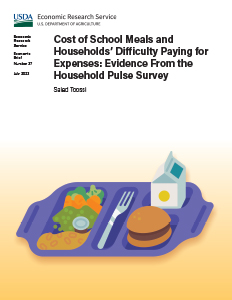Cost of School Meals and Households’ Difficulty Paying for Expenses: Evidence From the Household Pulse Survey
- by Saied Toossi
- 7/18/2023
Overview
School meals are typically served to children for free, at a reduced price, or at full price depending on their household income and size. In response to the Coronavirus (COVID-19) pandemic, the U. S. Department of Agriculture issued a waiver allowing schools to provide meals for free to all students, regardless of household income, in the 2020–21 and 2021–22 school years. This waiver expired on June 30, 2022, leading some advocates and policymakers to express concern that the reintroduction of prices for school meals could make it difficult for some households to meet their other expenses. This study finds that overall, nearly one-third of households with children ages 5–17 that paid for school meals in December 2022 reported that doing so made it difficult for them to pay for other usual expenses. The share reporting the same among households with school-aged children and incomes below 225 percent of the Federal poverty level, and among non-White households with school-aged children, was higher than the overall share.
How to Cite:
Toossi, S. (2023). Cost of school meals and households' difficulty paying for expenses: Evidence from the Household Pulse Survey (Report No. EB-37). U.S. Department of Agriculture, Economic Research Service. https://doi.org/10.32747/2023.8122123.ersDownload
-
Entire report
Download PDF -
Report summary
Download PDF

